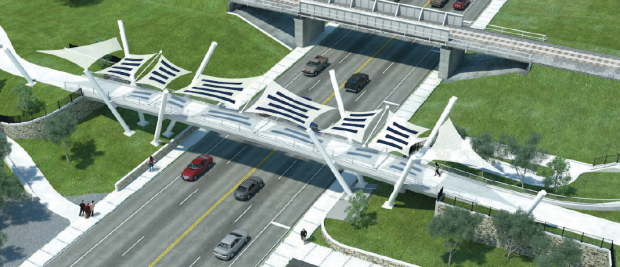Photovoltaic solar fabric products offer major potential to impact energy use—and make businesses in the industry hugely successful.
Coal and oil have superbly fueled and helped enable the extraordinary growth of modern civilization. Their supply is reaching its peak, though, and will soon start to decline—while our population continues to grow and its energy needs increase. The cumulative side effects of coal and oil use over time have significantly impacted our environment and health. For reasons like these, thousands of new companies—our company, Pvilion Inc., among them—have already formed to help develop and apply solar energy technology in order to maintain and improve a high standard of living for future generations.
Why it can work
Energy captured from sunlight falling on the earth could satisfy the world’s energy needs, so it is realistic to say that solar energy made affordable will follow coal and oil as the next big fuel. Because of the vastness of this booming industry many of the businesses that get into solar energy could make staggering sums of money. U.S. solar deployment has been roughly doubling every year for the past five years, according to Amory Lovins, chief scientist and co-founder of the Rocky Mountain Institute.
Companies that make fabric-based products have a unique opportunity to enter the solar energy business, since lightweight, flexible fabric material is an ideal vehicle for solar panels. Who will develop the first flexible photovoltaic (PV) solar fabric product that absolutely captures national and international market interest and goes viral? Which specialty fabrics companies will be the first solar fabric industry billionaires?
Solar can be beautiful
Pvilion’s principals have been part of the flexible PV fabric product business for 10 years, and have been involved with several flexible PV solar cell makers and the first applications of their technology into products. The company’s flexible PV technology is meeting the needs of the converging solar and construction industries: making solar installations beautiful and making beautiful buildings become “solar.”
Pvilion’s first major project was the “Solar Sail,” a two car-solar electric vehicle charging station in Pflugerville, Texas, which Pvilion designed, built and installed. The “Solar Sail” is an eye-catching and attractive, clean-energy landmark, prominently placed to help promote the Pflugerville Community Development Corporation’s dedication to sustainability and its interest in attracting “green” companies to move there. Pvilion has continued working with this city, with contracts to supply PV-powered solar LED street lights on its main thoroughfare and PV solar curtains in its new offices.
A recent project is for the new U.S. Embassy in London. Pvilion is providing technology, prototyping, manufacturing and installation for the 600 modular solar arrays which are part of the Outer Curtain Wall for the south, east and west facades of the embassy. Designed by Kieran Timberlake Architects, it will be the first building of its kind where three of the building’s facades are shaded with tensile structures and solar arrays, turning a “glass cube” into something more efficient and beautiful—and something visionary.
A Figg Engineering Group-designed pedestrian bridge in Tallahassee, Fla., will use Pvilion technology. The bridge will connect two different sections of a new linear park with flexible PV fabric tensile structures that power the colorful architectural lighting and provide shade for people walking across the bridge.
A new high-end residential tower in New York City with an all-glass façade needs sun-protection for the apartments. To create the necessary shade, Pvilion is providing floor-to-ceiling, flexible, PV-fabric blackout curtains covering 23,000 square feet of surface area. Two-inch by 12-foot-long PV strips will be integrated into the motorized fabric curtains. The electricity powered by the curtains is connected to the building grid and powers the lighting in the apartments.
More to come
New products and projects in development will use flexible PV fabric panels for clearspan rental tents; PV fabric strap-on accessories for clearspan, frame and pole-support rental tents; and a new airbeam-supported, clearspan tent for gala events on the roof terrace at Carnegie Hall in New York City. Many more applications and special projects are certainly possible with this technology.
There is the common perception that geography can make a place unsuitable for solar technology use, but in fact, most of the world’s solar panels are currently installed in a moderate-intensity solar environment. The sun is everywhere and solar panels will go everywhere; however, fewer of them are needed in a high-intensity solar environments. The solar-rich areas of the world would, logically, have the biggest sales.
Making it happen
Government funding for permanent, grid-tied solar panel installations can cover one-third to one-half of installed costs for typical, rigid solar panels, which is why they are selling as well as they are. This government support is a necessary part of transitioning to renewable energy, until scaling up brings production costs down.
Currently, there are no such government subsidies and rebates available for temporary solar panel installations—but there should be. An effort to secure government support for temporary solar panel installations—whether they are tied to a grid or not—would be worthwhile, and I think appropriate. Solar panels on specialty fabric products provide the same renewable energy, just in a different format. This would greatly accelerate the development of flexible PV fabric products.
Todd Dalland is a founder and president of Pvilion Inc., an integrator of flexible photovoltaic fabric-based products. He is the 2011 Recipient of the Wodetzki Award and a Fellow of the American Institute of Architects.
 TEXTILES.ORG
TEXTILES.ORG



